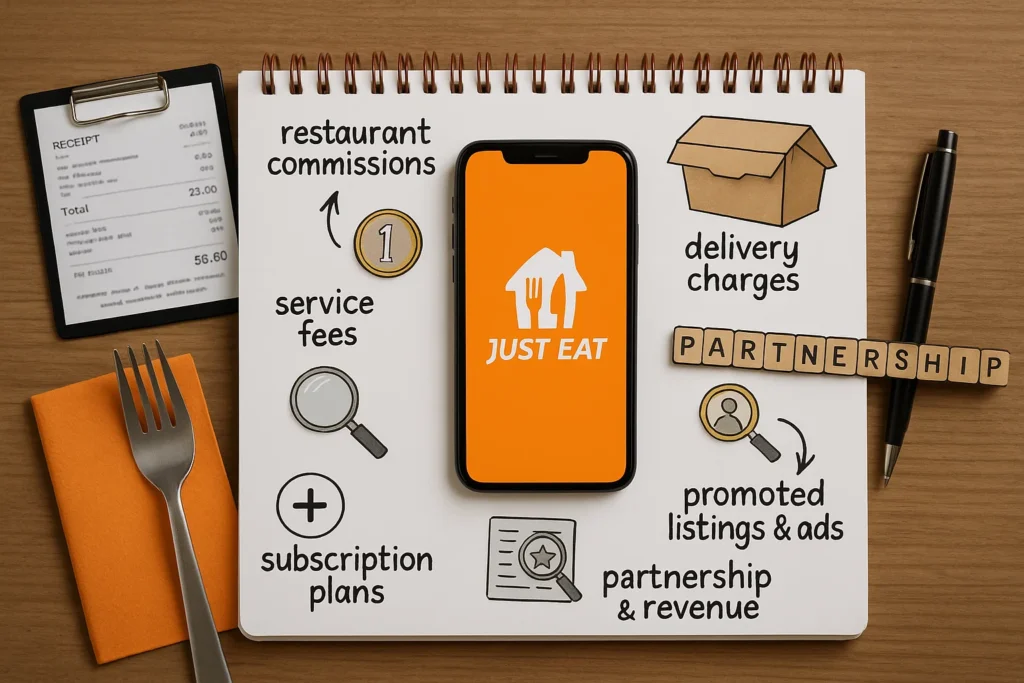Just Eat has become a household name in the online food delivery space, connecting hungry customers with their favorite local restaurants at the tap of a screen. Operating in over 20 countries, this UK-based platform has evolved from a simple takeaway ordering app to a multi-billion dollar logistics and delivery powerhouse.
But what truly powers its global success isn’t just convenience — it’s a smart, layered revenue model that monetizes each stakeholder in the ecosystem: customers, restaurants, and delivery partners.
In this blog, we’ll unpack how Just Eat earns money, the business logic behind its revenue model, and how startups can replicate this winning formula using a Just Eat clone solution from Miracuves.
Launch your food delivery startup with a top-rated food delivery app development company. Get scalable solutions tailored for both startups and enterprises.
How Just Eat Makes Money
Just Eat’s revenue model is multi-sided, allowing the platform to generate income from restaurants, customers, and third-party services. Here’s a snapshot of the primary revenue streams:
- Restaurant Commissions – Just Eat charges restaurants a percentage commission on every order placed through its platform.
- Delivery Charges – Customers pay a delivery fee, which may vary by location, distance, and restaurant policy.
- Service Fees – A small fee added to customer orders for platform maintenance and customer support.
- Subscription Plans – Offers Just Eat Plus, a monthly subscription that gives users free delivery and exclusive discounts.
- Promoted Listings & Ads – Restaurants can pay to appear higher in search results or get featured placements.
- Partnership & Affiliate Revenue – Earns via tie-ups with payment providers, grocery brands, or insurance for delivery partners.

Each stream contributes to a highly scalable, asset-light model that thrives on volume and digital interactions.
Detailed Breakdown of Revenue Channels
Restaurant Commissions
Just Eat’s primary income source is the commission charged to partner restaurants. On average, this ranges from 13% to 35% per order, depending on the services provided — such as delivery logistics and promotional support.
- Who Pays? Restaurants.
- How It Works? A fixed percentage of the order value is deducted before the payout to the restaurant.
- Why It Scales? More orders = more commission, without needing to own kitchens or make food.
Delivery Charges
For orders delivered by Just Eat’s own fleet or third-party couriers, customers are charged a delivery fee. This amount can be flat or dynamic based on distance and demand.
- Who Pays? End customers.
- How It Works? Delivery charges are added at checkout.
- Why It Scales? No cap on how many deliveries a fleet can fulfill daily — tech handles routing.
Service Fees
Just Eat applies an additional service fee on customer orders, usually a small fixed or percentage-based amount. This covers platform usage, customer support, and app maintenance.
- Who Pays? Customers.
- How It Works? Itemized on the final payment screen.
- Why It Scales? Low friction — often accepted as a platform norm.
Subscription Plans (Just Eat Plus)
For regular users, Just Eat offers a subscription model — Just Eat Plus — with benefits like free delivery, priority access, and occasional discounts for a monthly fee.
- Who Pays? Power users and frequent orderers.
- How It Works? Monthly billing with opt-out flexibility.
- Why It Scales? Increases loyalty and ensures recurring revenue.
Promoted Listings & Advertising
Restaurants can pay for featured placements within the app — such as top search results, homepage banners, or promo badges. This performance-based model boosts visibility and order volume for vendors.
- Who Pays? Restaurants and brands.
- How It Works? CPC (cost-per-click) or flat-fee placements based on campaign goals.
- Why It Scales? Every additional partner adds ad revenue without adding cost.
Partnership & Affiliate Revenue
Just Eat collaborates with partners like payment gateways, grocery stores, and delivery insurance providers to embed value-added services — and earns affiliate commissions or fixed partnership fees.
- Who Pays? Third-party service providers.
- How It Works? Revenue-sharing agreements based on transactions or leads.
- Why It Scales? Passive revenue with minimal effort and high relevance to users.
Discover the business model of Just Eat to see how the food delivery giant generates revenue. Learn what makes it profitable and what startups can adopt.
Why This Revenue Model Works in 2025
Just Eat’s revenue model isn’t just profitable — it’s built for the modern, on-demand economy. In 2025, several market and technology shifts are fueling its continued success:
Hyper-Growth of Online Food Delivery
The global food delivery market is projected to surpass $500 billion by 2025, driven by busy lifestyles, digital adoption, and rising smartphone penetration. Just Eat’s commission-based model naturally thrives in this high-volume environment.
Increased Acceptance of Platform Fees
Customers today are accustomed to paying service and delivery charges in exchange for speed and convenience. This shift in behavior makes Just Eat’s fee-driven model frictionless and scalable.
AI-Powered Logistics and Dynamic Pricing
AI and automation allow Just Eat to optimize delivery routes, dynamically price delivery fees, and forecast demand — reducing costs while increasing customer satisfaction and margin per order.
Brand-Driven Loyalty Programs
Subscription offerings like Just Eat Plus tap into consumer loyalty trends. With exclusive perks and savings, these programs increase retention and drive recurring revenue, especially among high-frequency users.
Asset-Light Operations
Unlike restaurant chains or dark kitchens, Just Eat doesn’t produce food. It monetizes existing infrastructure, which means low overhead and high potential for geographic expansion and partner acquisition.
Uncover the UberEats app marketing strategy that drives massive growth in food delivery. Apply these proven tactics to scale your own startup successfully.
Can Startups Replicate Just Eat’s Revenue Model?
Yes — and it’s more achievable than ever with the right tech partner.
While Just Eat’s model is powerful, building it from scratch requires massive investment in tech infrastructure, real-time logistics, partner onboarding systems, and a seamless multi-stakeholder interface. For many startups, that’s a long and expensive road.
That’s where Miracuves steps in.
With our ready-to-deploy Just Eat Clone, startups and digital agencies can instantly tap into a proven food delivery revenue model without reinventing the wheel. Our solution comes with:
- Restaurant commission engine with adjustable rates
- Customer-facing apps with integrated delivery tracking
- Dynamic pricing modules for delivery & service fees
- Subscription and loyalty features for user retention
- Restaurant dashboards for order, menu, and promo management
- Admin panel to oversee monetization and scale easily
From first order to recurring revenue — our Just Eat Clone helps you launch faster, monetize smarter, and scale without the tech debt.
The JustEat Clone by Miracuves is priced at $2,899, built for multi-restaurant food delivery businesses.
Launch a scalable platform with real-time ordering, tracking, and management features.
Go live in just 3–6 days with complete rebranding.
Compare the best UberEats clone scripts in 2025 with features and pricing to choose the right solution. Or kickstart your journey with affordable UberEats-like app development designed for startups.
Conclusion
Just Eat has mastered the art of monetizing food delivery — not just through restaurant commissions but by layering in service fees, delivery charges, advertising, subscriptions, and affiliate deals. In 2025, this diversified revenue model continues to thrive thanks to digital-first consumers, AI-driven logistics, and the popularity of convenience-based services.
For startups aiming to build the next Just Eat, replicating this model from the ground up can be daunting. But with Miracuves, it doesn’t have to be.
Our Just Eat Clone solution gives you the tech, tools, and monetization levers you need to launch a fully functional food delivery platform with a future-proof revenue model.
FAQs
How does Just Eat generate revenue?
Just Eat makes money through commissions from restaurants, delivery and service fees from customers, subscriptions like Just Eat Plus, promoted listings, and partnerships with third-party services.
Is Just Eat profitable in 2025?
While profitability varies across regions, Just Eat’s multi-layered monetization — especially through increased order volume and subscription growth — continues to drive strong revenue performance in 2025.
What are the main income sources for Just Eat?
Its primary income sources include restaurant commissions (13–35%), customer delivery and service charges, advertising from restaurant partners, paid subscriptions, and affiliate deals.
Can startups use the same revenue model as Just Eat?
Yes, startups can adopt this model, but building the tech infrastructure from scratch is costly. Using a Just Eat clone from Miracuves helps replicate the revenue model quickly and affordably.
Does Miracuves offer a Just Eat clone with monetization features?
Absolutely. Miracuves’ Just Eat Clone comes with restaurant commission controls, delivery fee settings, loyalty features, ad modules, and full admin oversight — all designed to help you monetize from day one.
Related Articles :-
- Revenue Model of Drizly: How the Alcohol Delivery App Pours in Profits
- Revenue Model of Delivery Hero: Inside the Business Behind the Global Food Delivery Giant
- Revenue Model of HungerStation: How Saudi Arabia’s Food Delivery Leader Drives Profit
- Revenue Model of OneCart: How South Africa’s Fast-Growing Delivery App Makes Money








